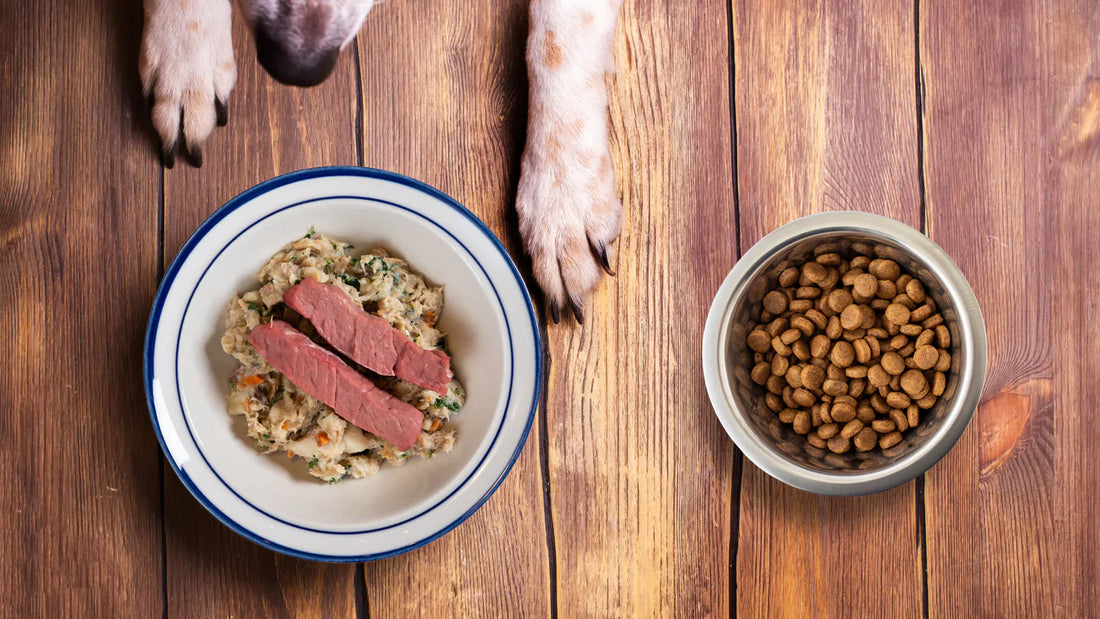
Fresh vs. Dry Dog Food: What’s Best for Your Dog’s Health?
Share This Post
Choosing the right food for your dog can feel overwhelming, with shelves stocked full of options. Two main players stand out: fresh, ready-to-eat food (think nutrient-packed meals sealed in pouches or trays) and traditional dry kibble. Both can keep your pup thriving, but fresh food has unique perks worth exploring. As a transparent resource for pet owners, we’re diving into the pros, cons, and health impacts of each to help you make an informed choice—no fluff, just facts.
What’s the Deal with Fresh and Dry Food?
Fresh Dog Food: These are ready-to-eat meals, often processed using retort technology—sealed in pouches or trays and gently cooked to lock in nutrients while staying shelf-stable without refrigeration until opened. They typically contain 70-80% moisture and use whole ingredients like meat, vegetables, and sometimes grains, offering a soft, flavorful texture dogs love.
Dry Dog Food: Known as kibble, this has about 10% moisture and is extruded into crunchy bites. It’s made from a mix of meats, grains, and nutrients, designed for long shelf life and easy storage.
The difference in moisture and processing sets the stage for how each impacts your dog’s health and your daily routine.
Fresh Dog Food: Why It Shines
Pros:
- Hydration Powerhouse: With 70-80% moisture, fresh food keeps your dog hydrated, supporting kidney and urinary health—ideal for dogs who skimp on water or have bladder issues.
- Top-Notch Nutrition: Retort processing preserves nutrients better than heavy extrusion, delivering high-quality proteins and vitamins closer to a home-cooked meal. Ingredients like named meats (e.g., chicken, beef) often lead the list, with fewer fillers.
- Irresistible Taste: The rich aroma and soft texture make fresh food a hit with picky eaters, seniors with dental woes, or dogs needing a health boost post-illness.
- Digestive Ease: Simpler, whole-food ingredients can be gentler on sensitive stomachs, reducing issues like bloating or loose stools.
Cons:
- Storage Needs: Unopened pouches or trays are shelf-stable, but once opened, they require refrigeration and should be used within a few days.
- Less Dental Scrub: Unlike kibble, fresh food doesn’t help scrape tartar, so regular tooth brushing or dental chews are a must.
Who It’s For: Fresh, ready-to-eat food is perfect for dogs needing hydration, flavor, or easier digestion—think finicky pups, older dogs, or those with specific health needs.
Dry Dog Food: The Classic Choice
Pros:
- Wallet-Friendly: Kibble costs less per pound, making it a go-to for big dogs or tight budgets.
- Super Convenient: It’s easy to store, doesn’t spoil quickly, and can sit out for grazers without fuss.
- Some Dental Benefit: The crunch can slow plaque buildup, though it’s no substitute for brushing.
Cons:
- Low Moisture: At just 10% water, kibble depends on your dog drinking enough separately. Without ample water, it could stress kidneys or urinary systems long-term.
- Taste Trade-Off: Some dogs find kibble less exciting, especially if it’s heavy on grains or lacks robust flavors.
- Quality Range: While high-end kibbles use great ingredients, cheaper ones lean on fillers like corn or wheat, which offer less nutrition than meat.
Who It’s For: Dry food works well for healthy, active dogs, budget-conscious owners. But not recommended for extended periods.
Nutrition: Getting It Right
Both fresh and dry foods can be “complete and balanced,” meeting FEDIAF standards for protein (18% minimum for adults, 25% for puppies), fat (5.5% minimum), and essential nutrients. Fresh food often has an edge with higher-quality proteins from whole meats, as retort cooking preserves amino acids better than kibble’s high-heat extrusion. For example, a fresh meal might derive 40-50% of its dry matter protein from muscle meat, while some kibbles hit 20-30% with plant-based boosts.
Always check labels: look for named meats over vague “by-products” and avoid excessive fillers. FEDIAF ensures safety, but quality varies—fresh food tends to mimic a natural diet more closely.
Health Impacts
- Kidneys and Hydration: Fresh food’s high moisture supports urinary health, reducing risks like stones or infections. Dry food requires proactive water intake to achieve the same.
- Weight Control: Fresh food’s protein density can help dogs feel satisfied with smaller portions, aiding weight management. Kibble’s lower calorie density suits high-energy dogs but needs careful measuring.
- Digestion: Fresh food’s whole ingredients often ease digestive issues, while kibble’s denser form can cause bloating in sensitive pups.
- Dental Health: Kibble may slow tartar, but fresh food’s softness doesn’t harm teeth—it just means you’ll need a dental routine.
Practical Considerations
- Cost: Fresh food’s premium ingredients mean a higher price, but for small dogs or occasional use, it’s manageable. Kibble wins for affordability, especially for large breeds.
- Storage and Travel: Fresh food’s sealed pouches are portable until opened, then need a fridge. Kibble’s no-fuss bags are travel champs.
- Waste: Fresh food pouches create more packaging than bulk kibble bags, but many brands now use recyclable materials.
- Feeding Flexibility: Fresh food can be a meal or topper to jazz up kibble, blending both worlds.
Switching Foods Safely
Thinking of trying fresh food? Transition slowly—mix a bit into your dog’s current food, increasing the ratio over 7-10 days to avoid upset stomachs. Watch for signs like diarrhea or lethargy, and consult your vet if they persist.
Tailoring to Your Dog
- Puppies: Fresh food’s soft texture and rich protein suit growing bodies, though quality kibble works if designed for pups.
- Seniors: Fresh food’s easy-to-eat form and hydration benefits aging dogs, especially those with weaker teeth or kidneys.
- Health Needs: Dogs with allergies or digestive issues often thrive on fresh food’s cleaner ingredients, while healthy dogs can do well on either.
The Bottom Line
Fresh, ready-to-eat food stands out for its hydration, taste, and nutrient quality, making it a fantastic choice for dogs who need a health boost or just love a tasty meal. Dry food holds its own with convenience and cost, perfect for busy owners or robust pups. Neither is “better”—it’s about what fits your dog’s body and your lifestyle.
Check with your vet, read those labels, and pay attention to how your dog feels. Whether you go fresh, dry, or a mix, the goal is a wagging tail and a healthy life
